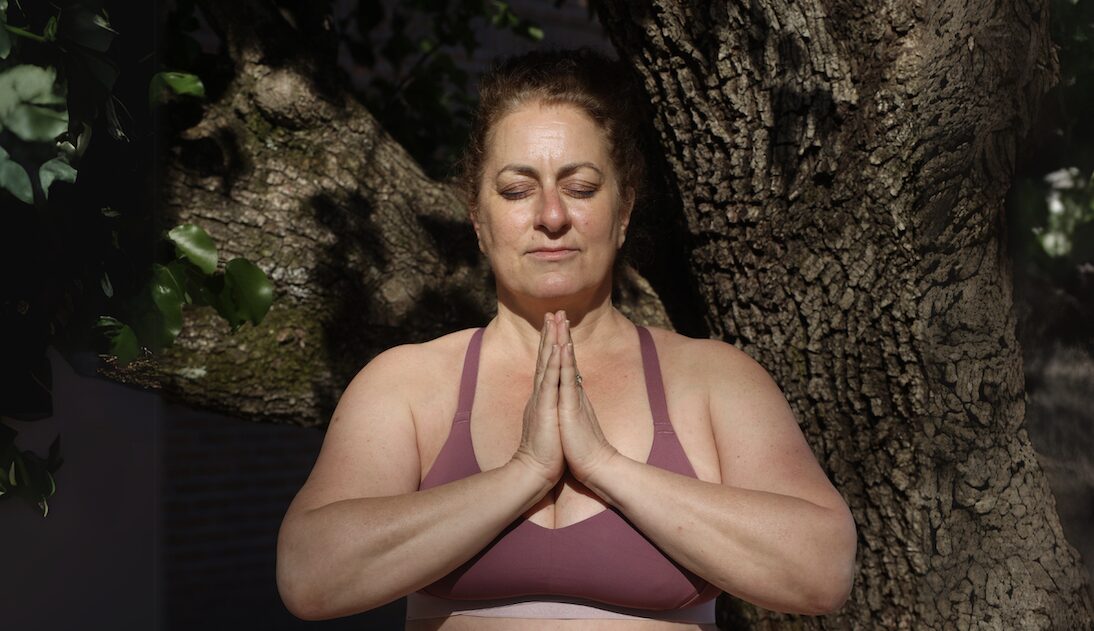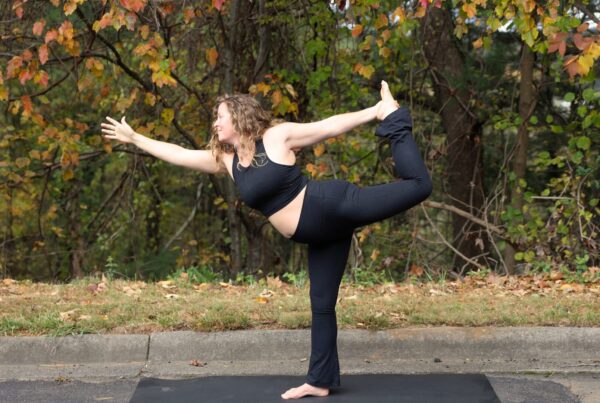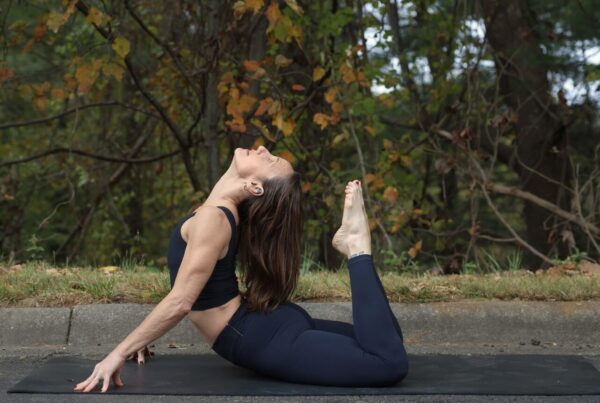
For our May Student Ambassador Michelle Moog-Koussa, taking her yoga class at 5:30 on weekdays is non-negotiable. And if she’s not there, chances are she is traveling as part of her job as director of the Bob Moog Foundation, and she’s probably doing a hot yoga class wherever she has traveled.
“Thank God there’s a 5:30 class,” she said. “I have to leave work at 5, which is a saving grace, or I might be at my desk until 9. I don’t care if it’s Hot Power Flow, Hot Align Flow, Hot 26, Inferno. Whatever they’re doing at 5:30, I’m there for it.”
Michelle, who first moved to Asheville with her family when she was 10 years old, has been practicing at HYA since 2012 and she is as integral a part of the HYA community as she is the Asheville community at large. For many years she owned a boutique downtown, but since 2005 she has led the foundation that honors her father’s invention and career, which now also includes a museum downtown — the Moogseum.
“At one point in 2012, my job was becoming very stressful and I was looking for a way to stay in shape,” she said. “I did Pilates for a little bit but that studio closed between Christmas Eve and New Year’s and I thought, what good does that do me? With the job I have, that’s the one week I have free when I can actually work out. Then I saw an ad for Hot Yoga Asheville in its previous name and it was for 8 classes for $20. I was a little scared.
“I went four times during those 8 days and I was hooked. That was 1,665 classes ago. I practice yoga somewhere between 4-5 times a week. I travel a lot for work. I make sure my hotel is near a hot yoga studio. Everywhere I go, I do hot yoga even if it’s abroad. In those 12 years, I have been through some pretty massive ups and downs in my professional life and in my health journey. Hot yoga has seen me through all of it.”
When Michelle began practicing, HYA offered exclusively the Hot 26 series, then known as Bikram yoga. But her practice has expanded and adapted along with the studio. I helped her through a bout of breast cancer in 2018 and all the ups and downs of life, including a tough time in her career that came right after she started at HYA.
“I just felt during that period, and later a health crisis, that every class saved me.” she said. “I would come into class full of difficult energy knowing I would feel totally clarified, physically, mentally, emotionally and spiritually when I got out.
“I think I would have gone insane without it. I also think it was a gift for my family, because instead of projecting onto them, I was able to come home a lot more centered and treat them with the love and calmness that they should have been treated with.”
Read more about Michelle’s story:
HYA: How did your career bring you to lead the Bob Moog Foundation?
Michelle: I went to George Washington University, majored in political science with full intention to go to law school. I wanted to be an attorney for the Environmental Protection Agency. Instead of wound up moving to West Africa for four and a half years because that’s where Joseph is from. I had met Joseph through my sister, who was in the Peace Corps in Senegal, and we had a long distance romance for about a year and I decided to move over there. I skipped going to law school. Had my son Gregory in Senegal, then later my daughter Yasmine. We came back here not knowing exactly what we were going to do. I worked for my father for about a year and then I started my own small business. I had a small gift boutique downtown called Amore. I did that while I was raising my kids. I wanted to do something where I could make my own hours and spend lots of time with my babies, which I did.
And then my dad died of a brain tumor. And while he was my dad to me, he was something very different to the rest of the world, which we discovered over the three months and three years that he was sick and based on the outpouring from all over the world about how Bob Moog had inspired their lives, we decided to create a foundation in his name to carry on his legacy. My brother started it but didn’t want to do it anymore. Nobody in my family volunteered except for me.
I really felt that being able to harness the inspiration my dad had professionally cultivated and use it as a vehicle to inspire people was a chance I was only going to get once in my life. And it was an opportunity that not only deserved to be carried forward but almost demanded to be carried forward. So I jumped in.
HYA: How much has the foundation grown?
Michelle: I worked out of my basement by myself for five years before we got some wonderful support from the industry which allowed me to get an office downtown, hire a few people on my staff. We slowly started to grow our programs. We created Dr. Bob’s Sound School, which teaches second graders about the science of sound through music and technology. It’s a 10-week curriculum that meets state and national standards. It’s highly experiential and multi-sensory. That has grown from serving 7 classrooms to nearly 100 classrooms. We serve about 3,000 children a year in Buncombe County, about 40,000 kids over that time. Very early in the foundation we decided we wanted to create a museum and we started that effort in 2008. Then the dot-com bubble burst and ended those dreams until 2018 when a space came open and we were able to open the Moogseum in May 2019. We were also growing the Bob Moog Foundation Archive that has more than 15,000 items in it that we share with researchers and journalists and other museums. It’s been a lot of growth. We’re still a small organization. But we weathered a lot of stuff.
HYA: You said you weren’t totally aware of the impact of your dad’s work until he died, right?
Michelle: I realized it superficially. When I was five, my mom sat us down and said, you’re father’s going to be on TV and we’re going to sit down and watch. Which was a big deal because we weren’t allowed to watch much TV. We sat down and To Tell the Truth comes on. I just had this kind of out-of-body surreal experience when my dad walked out. That was my first introduction to Bob Moog. We knew dad invented the synthesizer and dad was famous and he was gone a lot and he worked a lot. And we knew that there were famous and creative and eccentric people who came to the house. Not a lot but some. They were all wonderful. My dad loved them. When I was in ninth grade in my physical science class first day of school and I went to Irwin High School. We were leafing through our physical science textbook and someone goes, that’s Mimi’s daddy. My dad was very humble. He didn’t make a big deal out of it. He was not comfortable with fame. I went flush. We all turned to the page and there was my dad staring back at me. There was this whole section about Bob Moog and his accomplishments.
When he was sick and passed away, the outpouring was incredible. Those people who were writing us, they introduced us to Bob Moog. I would just sit there and cry. The wall that my dad built came down, the sun came beaming in. And my poor little psyche had no choice but to reckon with things I had not been exposed to before.
HYA: How has your practice supported you through this journey?
Michelle: At the very beginning, I had favorite teachers. And then, the universe taught me how every teacher brought something different. Every class there was something new, even if it was tiny. Some little piece of instruction, some little piece of wisdom, some information about yoga itself. I love that. I love knowing you are going to come in and be instructed and you’re going to open up in some way every time.
These pieces of wisdom that you guys offer us, I take those home with me. When my kids were teenagers, I would talk about them. You know what my yoga teachers tell us, you meet yourself where you are, on your mat. You don’t have to worry about the person in the first row that’s got their heel above their head. Meet yourself where you are. That was an important lesson for them too. There were all kinds of things like that.






